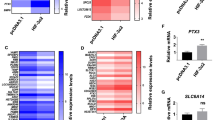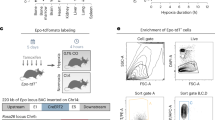Abstract
Circulating erythropoietin (EPO) is mainly produced by the kidneys and mediates erythrogenesis in bone marrow and nonhematopoietic cell survival. EPO is also produced in other tissues where it functions as a paracrine. Moreover, the hypoxic induction of EPO is known to be mediated by HIF-1α and HIF-2α, but it remains obscure as to which of these two mediators mainly contributes to EPO expression. Thus, we designed in vivo experiments to evaluate the contributions made by HIF-1α and HIF-2α to EPO expression. In mice exposed to mild whole body hypoxia, HIF-1α and HIF-2α were both induced in all tissues examined. However, EPO mRNA was expressed in kidney and brain, but not in liver and lung. Likewise, chromatin immunoprecipitation (CHIP) analyses demonstrated that HIF-1α or HIF-2α binding to the EPO gene increased under hypoxic conditions only in kidney and brain. A comparison of CHIP data and EPO mRNA levels suggested that, during mild hypoxia, renal EPO transcription is induced equally by HIF-1α and HIF-2α, but that brain EPO is mainly induced during hypoxia by HIF-2α. Thus, HIF-1α and HIF-2α appear to contribute to EPO expression tissue specifically.



Similar content being viewed by others
References
Jelkmann W (2004) Molecular biology of erythropoietin. Intern Med 43:649–659
Brines M, Cerami A (2006) Discovering erythropoietin’s extra-hematopoietic functions: biology and clinical promise. Kidney Int 70:246–250
Baker JE (2005) Erythropoietin mimics ischemic preconditioning. Vascul Pharmacol 42:233–241
Kilic E, Kilic U, Soliz J, Bassetti CL, Gassmann M, Hermann DM (2005) Brain-derived erythropoietin protects from focal cerebral ischemia by dual activation of ERK-1/-2 and Akt pathways. FASEB J 19:2026–2028
Stockmann C, Fandrey J (2006) Hypoxia-induced erythropoietin production: a paradigm for oxygen-regulated gene expression. Clin Exp Pharmacol Physiol 33:968–979
Wang GL, Semenza GL (1996) Molecular basis of hypoxia-induced erythropoietin expression. Curr Opin Hematol 3:156–162
Semenza GL (2001) Hypoxia-inducible factor 1: oxygen homeostasis and disease pathophysiology. Trends Mol Med 7:345–350
Schofield CJ, Ratcliffe PJ (2004) Oxygen sensing by HIF hydroxylases. Nat Rev Mol Cell Biol 5:343–354
Lando D, Peet DJ, Whelan DA, Gorman JJ, Whitelaw ML (2002) Asparagine hydroxylation of the HIF transactivation domain a hypoxic switch. Science 295:858–861
Wang GL, Semenza GL (1995) Purification and characterization of hypoxia-inducible factor 1. J Biol Chem 270:1230–1237
Park JW, Chun YS, Kim MS (2004) Hypoxia-inducible factor 1-related diseases and prospective therapeutic tools. J Pharmacol Sci 94:221–232
Wiesener MS, Turley H, Allen WE, Willam C, Eckardt KU, Talks KL et al (1998) Induction of endothelial PAS domain protein-1 by hypoxia: characterization and comparison with hypoxia-inducible factor-1alpha. Blood 92:2260–2268
Wiesener MS, Jurgensen JS, Rosenberger C, Scholze CK, Horstrup JH, Warnecke C et al (2002) Widespread hypoxia-inducible expression of HIF-2alpha in distinct cell populations of different organs. FASEB J 17:271–273
Chun YS, Choi E, Kim GT, Lee MJ, Lee MJ, Lee SE et al (2000) Zinc induces the accumulation of hypoxia-inducible factor (HIF)-1alpha, but inhibits the nuclear translocation of HIF-1beta, causing HIF-1 inactivation. Biochem Biophys Res Commun 268:652–656
Jung JE, Lee HG, Cho IH, Chung DH, Yoon SH, Yang YM et al (2005) STAT3 is a potential modulator of HIF-1-mediated VEGF expression in human renal carcinoma cells. FASEB J 19:1296–1298
Stroka DM, Burkhardt T, Desbaillets I, Wenger RH, Neil DA, Bauer C et al (2001) HIF-1 is expressed in normoxic tissue and displays an organ-specific regulation under systemic hypoxia. FASEB J 15:2445–2453
Cai Z, Manalo DJ, Wei G, Rodriguez ER, Fox-Talbot K, Lu H et al (2003) Hearts from rodents exposed to intermittent hypoxia or erythropoietin are protected against ischemia-reperfusion injury. Circulation 108:79–85
Yoon D, Pastore YD, Divoky V, Liu E, Mlodnicka AE, Rainey K et al (2006) Hypoxia-inducible factor-1 deficiency results in dysregulated erythropoiesis signaling and iron homeostasis in mouse development. J Biol Chem 281:25703–25711
Rosenberger C, Mandriota S, Jurgensen JS, Wiesener MS, Horstrup JH, Frei U et al (2002) Expression of hypoxia-inducible factor-1alpha and -2alpha in hypoxic and ischemic rat kidneys. J Am Soc Nephrol 13:1721–1732
Warnecke C, Zaborowska Z, Kurreck J, Erdmann VA, Frei U, Wiesener M et al (2004) Differentiating the functional role of hypoxia-inducible factor (HIF)-1alpha and HIF-2alpha (EPAS-1) by the use of RNA interference: erythropoietin is a HIF-2alpha target gene in Hep3B and Kelly cells. FASEB J 18:1462–1464
Chavez JC, Baranova O, Lin J, Pichiule P (2006) The transcriptional activator hypoxia inducible factor 2 (HIF-2/EPAS-1) regulates the oxygen-dependent expression of erythropoietin in cortical astrocytes. J Neurosci 26:9471–9481
Scortegagna M, Ding K, Zhang Q, Oktay Y, Bennett MJ, Bennett M et al (2004) HIF-2alpha regulates murine hematopoietic development in an erythropoietin-dependent manner. Blood 105:3133–3140
Gruber M, Hu CJ, Johnson RS, Brown EJ, Keith B, Simon MC (2007) Acute postnatal ablation of Hif-2{alpha} results in anemia. Proc Natl Acad Sci U S A 104:2301–2306
Rankin EB, Biju MP, Liu Q, Unger TL, Rha J, Johnson RS et al (2007) Hypoxia-inducible factor-2 (HIF-2) regulates hepatic erythropoietin in vivo. J Clin Invest 117:1068–1077
Chikuma M, Masuda S, Kobayashi T, Nagao M, Sasaki R (2000) Tissue-specific regulation of erythropoietin production in the murine kidney, brain, and uterus. Am J Physiol Endocrinol Metab 279:E1242–E1248
Eckardt KU, Dittmer J, Neumann R, Bauer C, Kurtz A (1990) Decline of erythropoietin formation at continuous hypoxia is not due to feedback inhibition. Am J Physiol 258:F1432–F1437
Eckardt KU, Pugh CW, Meier M, Tan CC, Ratcliffe PJ, Kurtz A (1994) Production of erythropoietin by liver cells in vivo and in vitro. Ann N Y Acad Sci 718:50–60
Acknowledgment
This work was supported by the Korea Science and Engineering Foundation grant funded by the Korean government (MOST; No. R01-2006-000-10977).
Author information
Authors and Affiliations
Corresponding author
Rights and permissions
About this article
Cite this article
Yeo, EJ., Cho, YS., Kim, MS. et al. Contribution of HIF-1α or HIF-2α to erythropoietin expression: in vivo evidence based on chromatin immunoprecipitation. Ann Hematol 87, 11–17 (2008). https://doi.org/10.1007/s00277-007-0359-6
Received:
Accepted:
Published:
Issue Date:
DOI: https://doi.org/10.1007/s00277-007-0359-6




